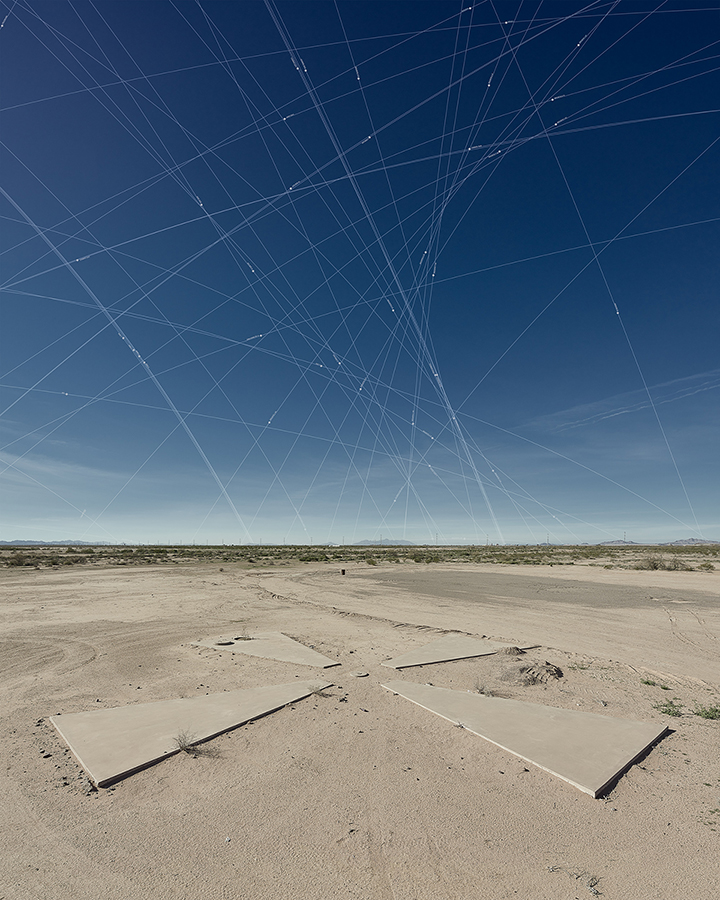Artifacts and Orbits—An Evening of Art & Science Inquiry

When
Where
Artifacts and Orbits—An Evening of Art & Science Inquiry
Thursday, November 9th 5:30-7pm
Join us for a multidisciplinary panel in conjunction with the current exhibition Invisible to the Eye featuring Damon Sauer, Julie Anand, Dr. Beth O’Leary, and Dr. Moriba K. Jah. Phoenix-based artist collaborators Sauer and Anand will introduce their current project featured in the exhibition, Ground Truth: Corona Landmarks, in which they photograph the remains of Cold War satellite calibration targets that were part of the first spy satellite program and then digitally render a map of orbiting satellites in the sky overhead. The project not only addresses the origins of satellite technology but also the massive information network in which we are all currently suspended and reliant upon. Dr. O’Leary, a space archeaologist and Professor Emerita in the Department of Anthropology at New Mexico State University will speak to the ways in which artifacts on Earth connected with space exploration as well as the artifacts human beings distribute beyond the Earth’s surface are ripe for archaeological consideration. Dr. Jah, an astrodynamist and Associate Professor in Aerospace Engineering and Engineering Mechanics at the University of Texas at Austin will inform us from his perspective on problems in space traffic and the long-term sustainability of space activities. The panel will be moderated by Dr. Kate Albers, Associate Professor in the UA School of Art, whose current work explores the intersection of photography, geolocational technology, and landscape.
Damon Sauer and Julie Anand are collaborative artists based in Phoenix, Arizona whose conceptually-driven practice explores notions of boundaries. They have been collaborating for thirteen years. Anand is Associate Professor within the Photography area of the School of Art at Arizona State University and Senior Sustainability Scholar at ASU’s Global Institute of Sustainability. Anand and Sauer’s current ongoing project, Ground Truth: Corona Landmarks, was selected this year for the national Sidney Zuber Award by the Phoenix Art Museum, the international Lensculture Exposure Award by curator Duan Yuting of China and the national Critical Mass Juror’s Pick by curator Peggy Sue Amison of Dubai. Exhibitions in 2017 include Broken Ground: New Directions in Land Art at the Florida State Art Museum, Totality at Oregon State University as well as the Athens Photo Festival at the Benaki Museum in Greece. Ground Truth received attention this year in Wired magazine, Hyperallergic, and Politiken (print newspaper of Denmark). The collaborative team looks forward a solo exhibition of the ongoing work at the National Academy of Sciences in Washington, DC in 2018. The project is supported this year by the Land Arts Mobile Research Center/Andrew Mellon Foundation.
https://placesjournal.org/article/skywatching/
Dr. Beth Laura O’Leary is currently Professor Emerita in the Department of Anthropology at New Mexico State University where she created the Cultural Resource Management Certificate Program. She has been a leader in the emerging field of Space Archaeology and Heritage. With a grant from NASA, she investigated the archaeological assemblage and the international heritage status of the Apollo 11 Tranquility Base site on the Moon. In 2010, she and students successfully nominated the objects and structures at the Tranquility Base site to State Register of Cultural Properties. She is a member of the World Archaeological Congress Space Heritage Task Force. The Handbook of Space Engineering, Archaeology and Heritage by Beth O’Leary with her co-editor Ann Darrin was published in 2009; The Archaeology and Heritage of the Human Movement into Space (with co-editor, P.J.Capelotti); and most recently Dr. O’Leary with L.Westwood and M.W. Donaldson wrote The Final Mission: Preserving NASA’s Apollo Sites. As a recognized expert in this field she has been interviewed by the international media, including among others: Smithsonian, National Geographic, NPR, New York Times, LA Times, Deutsche Radio, and many others. She has written for BBC Radio 3 and the Washington Post.
https://anthropology.nmsu.edu/anthropology-faculty/oleary/
Dr. Moriba K. Jah is currently an Associate Professor in the Aerospace Engineering and Engineering Mechanics department, Cockrell School of Engineering, at the University of Texas at Austin where he also serves as the Director of the Advanced Sciences and Technology Research In Astronautics (ASTRIA) program, focused on solving astrodynamics problems in Space Traffic, Orbital Safety, and Long-Term Sustainability of Space Activities. Dr. Jah is a Fellow of the American Astronautical Society (AAS), the Air Force Research Laboratory (AFRL), the International Association for the Advancement of Space Safety (IAASS), and the Royal Astronomical Society (RAS). He’s also an Associate Editor for Advances in Space Research, the official journal of the Committee On Space Research (COSPAR).
https://sites.utexas.edu/moriba
Dr. Kate Palmer Albers is Associate Professor in the Art History Division, with a speciality in the History and Theory of Photography. Her book, Uncertain Histories: Accumulation, Inaccessibility, and Doubt in Contemporary Photography (University of California Press, 2015), addresses the limits of photography's ability to narrate the past and argues that doubt and inaccessibility can generate a space for a productive uncertainty that is as culturally valuable as information and clarity. Albers’ current work focuses on the intersection of photography, geolocational technology, and landscape, and she is developing new research on photographic communication through social media. She is also interested in the role of digital technologies in art historical research and contemporary practice, as well as teaching. She organized the exhibition Locating Landscape: New Strategies, New Technologies which looked at the intersection of photography, mapping, technology, and landscape, and appeared at the Sam Lee Gallery (Los Angeles, 2009) and the Center for Creative Photography (Tucson, AZ, 2010). In 2010 she participated in the NEH Summer Institute Mapping and Art in the Americas at the Newberry Library in Chicago.
http://art.arizona.edu/people/directory/kpalbers/

